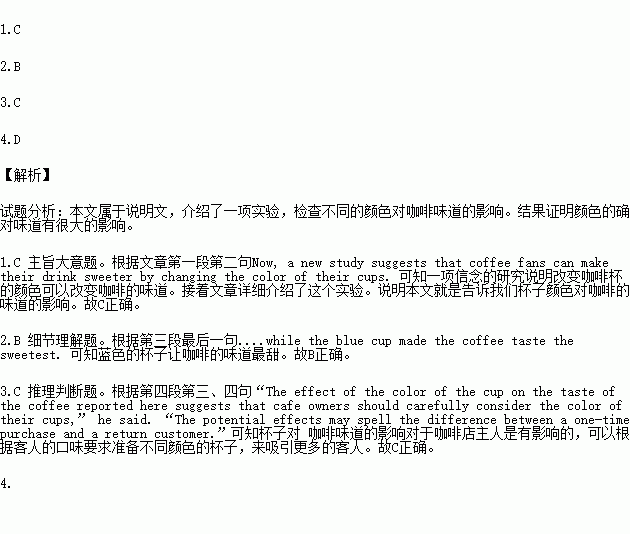题目内容
More than 2.25 billion cups of coffee are drunk throughout the world each day, and it's likely that many taste bitter. Now, a new study suggests that coffee fans can make their drink sweeter by changing the color of their cups.
Researchers from Oxford set out to prove whether the claim that coffee drunk from a white cup tastes biter was true. They used 36 volunteers and three different colored cups---blue, white and transparent glass--- to examine the claim.
In one experiment, the white cup increased the intensity (浓度) of the coffee taste relative to the transparent cup. Then, in a second experiment, coffee drunk from the white cup was found to taste less sweet when compared to the other colored cups, while the blue cup made the coffee taste the sweetest.
The scientists believe that the color brown may be associated with bitterness, and coffee in a white cup appears the brownest. “Our study clearly shows that the color of a cup does influence our sense of the coffee taste,” leading author Dr George Doorn, wrote in an article for The Conversation. “The effect of the color of the cup on the taste of the coffee reported here suggests that cafe owners should carefully consider the color of their cups,” he said. “The potential effects may spell the difference between a one-time purchase and a return customer.” Actually, the idea that color can change the food and drink taste came out many years ago. A study published last year reported that red, strawberry-flavored cake served on a white plate was rated as 10 percent sweeter than the same food presented on a black plate.
1.The passage is mainly about _____.
A. the popularity of sweet coffee.
B. an experiment made in Oxford.
C. the effect of cup color on coffee's taste
D. useful tips on how to make coffee.
2. In which cup will coffee taste the sweetest?
A. A white cup. B. A blue cup.
C. A transparent cup D. A brown cup
3. Café owners should consider their cups' color in order to ______.
A. reduce the daily expenses
B. show their taste in coffee
C. appeal to more customers
D. make their café different.
4.We learn from the passage that_____.
A. coffee in a white cup tastes sweeter than that in a transparent glass
B. over 2 billion cups of sweet coffee are drunk worldwide each year.
C. Dr. George Doorn wrote an article about making conversations.
D. the idea that color could affect the taste of drink is not new.
 阅读快车系列答案
阅读快车系列答案
